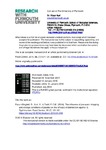The influence of pre-wash chopping and storage conditions of parsley on the efficacy of disinfection against S. Typhimurium
| dc.contributor.author | Faour-Klingbeil, D | |
| dc.contributor.author | Kuri, V | |
| dc.contributor.author | Todd, ECD | |
| dc.date.accessioned | 2018-12-10T13:10:22Z | |
| dc.date.available | 2018-12-10T13:10:22Z | |
| dc.date.issued | 2016-01-13 | |
| dc.identifier.issn | 0956-7135 | |
| dc.identifier.issn | 1873-7129 | |
| dc.identifier.uri | http://hdl.handle.net/10026.1/13011 | |
| dc.description.abstract |
Initial chopping of parsley before washing for subsequent processing into ready-to-eat foods later in the day is common in some restaurants. The aim was to evaluate the influence of pre-wash chopping on the S. Typhimurium decontamination by common washing and disinfection methods including the use of vinegar (4%, v/v, acetic acid), 0.25 g/l sodium dichloroisocyanurate (NaDCC), and water combined with manual agitation. This study demonstrated limited efficiency of applied methods and that holding pre-wash chopped leaves at 30 °C reduced the effectiveness of all washing solutions. Scanning electron microscopy (SEM) imaging indicated initiation of biofilm formation after 24 h at 5 °C with noticeable adhesion of cells to inaccessible folds of the vein on the leaf surface. NaDCC was shown to be the most effective solution achieving log reductions of 1.92–3.12 on intact parsley leaves. The latter being on those held at 5 °C for 4 h; However, its effectiveness was reduced by 0.73–0.93 and 1.19 log cfu/g on chopped leaves at 5 °C and on both intact and chopped leaves at 30 °C, respectively. In conclusion, strict temperature control and avoiding pre-wash chopping are highly recommended during handling of parsley for the optimal elimination of pathogenic microorganisms. | |
| dc.format.extent | 121-131 | |
| dc.language | en | |
| dc.language.iso | en | |
| dc.publisher | Elsevier | |
| dc.rights | Attribution-NonCommercial-NoDerivatives 4.0 International | |
| dc.rights | Attribution-NonCommercial-NoDerivatives 4.0 International | |
| dc.rights.uri | http://creativecommons.org/licenses/by-nc-nd/4.0/ | |
| dc.rights.uri | http://creativecommons.org/licenses/by-nc-nd/4.0/ | |
| dc.subject | S. Typhimurium | |
| dc.subject | Parsley | |
| dc.subject | SEM | |
| dc.subject | Restaurants | |
| dc.subject | Sodium dichloroisocyanurate | |
| dc.subject | Biofilms | |
| dc.title | The influence of pre-wash chopping and storage conditions of parsley on the efficacy of disinfection against S. Typhimurium | |
| dc.type | journal-article | |
| dc.type | Article | |
| plymouth.author-url | https://www.webofscience.com/api/gateway?GWVersion=2&SrcApp=PARTNER_APP&SrcAuth=LinksAMR&KeyUT=WOS:000384626500016&DestLinkType=FullRecord&DestApp=ALL_WOS&UsrCustomerID=11bb513d99f797142bcfeffcc58ea008 | |
| plymouth.volume | 65 | |
| plymouth.publication-status | Published | |
| plymouth.journal | Food Control | |
| dc.identifier.doi | 10.1016/j.foodcont.2016.01.019 | |
| plymouth.organisational-group | /Plymouth | |
| plymouth.organisational-group | /Plymouth/Faculty of Science and Engineering | |
| plymouth.organisational-group | /Plymouth/REF 2021 Researchers by UoA | |
| plymouth.organisational-group | /Plymouth/REF 2021 Researchers by UoA/UoA06 Agriculture, Veterinary and Food Science | |
| plymouth.organisational-group | /Plymouth/Users by role | |
| plymouth.organisational-group | /Plymouth/Users by role/Academics | |
| dcterms.dateAccepted | 2016-01-12 | |
| dc.identifier.eissn | 1873-7129 | |
| dc.rights.embargoperiod | Not known | |
| rioxxterms.versionofrecord | 10.1016/j.foodcont.2016.01.019 | |
| rioxxterms.licenseref.uri | http://creativecommons.org/licenses/by-nc-nd/4.0/ | |
| rioxxterms.licenseref.startdate | 2016-01-13 | |
| rioxxterms.type | Journal Article/Review |



